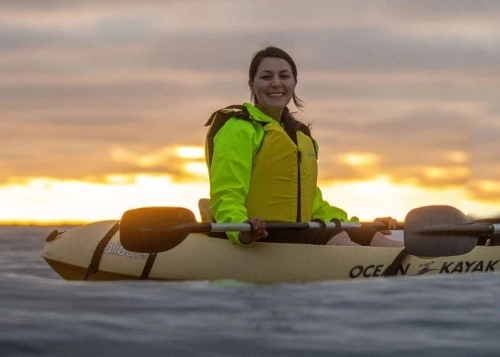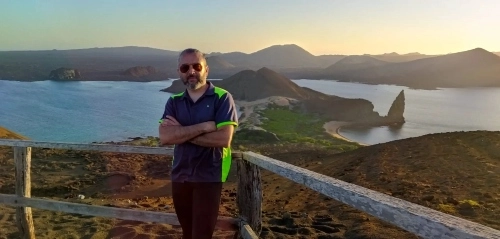Galápagos es un gran destino para casi todo el mundo. Los amantes de la naturaleza apreciarán una experiencia transformadora con la vida silvestre y una vista de primera mano de cómo se forman las islas. Es un gran lugar para que los recién casados o las familias escapen de la vida cotidiana y encuentren tiempo de calidad. Si está buscando un destino de playa convencional, las mejores tiendas y opciones de entretenimiento tradicionales, probablemente este no sea para usted.
Las Islas Galápagos are a perfect destination for everyone who wants to be amazed. Even if wildlife watching is not your main reason for coming, you will still be impressed by the incredible landscapes, savoury Ecuadorian cuisine, local hospitality and wide range of activities. Read our blog about the best time to go to the Galapagos.
Sí. Las Galápagos son una experiencia de aprendizaje impresionante para todos los grupos de edad, aunque en algunos cruceros se aplican restricciones de edad.
Realmente depende del tipo de discapacidad y de hasta qué punto esta afectaría a la visita de la persona. Las personas con graves problemas de movilidad se encontrarán con que Galápagos tiene un terreno increíblemente irregular, sin rampas de acceso en los lugares de visita. Las sillas de ruedas estarían expuestas regularmente al agua salada, lo que podría dañarlas. El único operador turístico que ofrece actualmente servicios especializados para personas en silla de ruedas es Ecuador para Todos.
Durante la estación cálida, las corrientes de agua más templadas permitirán nadar sin traje de buceo. Si tienes previsto nadar mucho o bucear con tubo, quizá le interese llevar uno porque se moverá menos. Durante la estación seca, el agua se enfría debido a las corrientes más frías y algunos huéspedes prefieren llevar traje de buceo más a menudo.
Si se solicita con antelación, se pueden satisfacer la mayoría de las necesidades dietéticas especiales. Los barcos con varias rutas suelen tener más personal de cocina que los barcos con una sola ruta, por lo que es más probable que puedan atender peticiones especiales.
Ningún barco en Galápagos ofrece un servicio religioso de ninguna denominación. En las opciones con base en tierra, casi siempre hay un pueblo cercano con iglesia, pero solo de confesión cristiana. Ponte en contacto con el experto de tu destino para informarte sobre requisitos específicos.
Los niños menores de 6 años necesitan un permiso especial de sus padres o tutores para embarcar en un crucero por las Galápagos. Los menores de 18 años que viajen acompañados de un solo progenitor/tutor legal deben tener un formulario de consentimiento del menor firmado por el otro progenitor o, en el caso de un tutor legal, por ambos progenitores. La edad mínima para consumir alcohol en Ecuador es de 18 años.
La mejor opción sería optar por un crucero multi-guiado o una excursión por tierra. En cualquiera de estas dos opciones, habrá múltiples actividades disponibles simultáneamente, lo que significa que los más activos del grupo podrán salir a pasear, mientras que los que prefieran un viaje más relajado podrán contemplar las vistas con calma.
Nuestro director gastronómico certificado por Le Cordon Bleu ha diseñado cuidadosamente los buffets y menús a bordo de todos nuestros cruceros. Están inspirados en sabores locales e internacionales. A lo largo del día se servirán comidas variadas compuestas de todos los grupos de alimentos. También se incluyen productos frescos, frutas y proteínas que se adquieren de los mejores proveedores disponibles.
Nuestros guías naturalistas siempre tienen un par de binoculares que le pasarán cuando haya algo interesante que ver. No dude en traer los suyos si lo que realmente le gusta es observar la vida silvestre.
Un buen par de zapatos para caminar, idealmente con un buen nivel de tracción y agarre en la parte inferior.
Las baterías, las bolsas de cámara resistentes a la intemperie y las tarjetas de memoria adicionales serán útiles. Las carcasas impermeables serán necesarias si desea llevar su cámara bajo el agua. Los trípodes también son útiles si quieres tomar fotos del cielo nocturno.
La fotografía con flash no está permitida cuando se toman fotografías de la vida silvestre. Las fotografías y videos profesionales grabados con fines comerciales deben ser autorizados por el Parque Nacional Galápagos. Los drones solo se pueden usar con un permiso especial.
Galápagos está considerado uno de los mejores destinos de buceo del mundo. Sin embargo, los visitantes deben tener en cuenta las normas del Parque Nacional que definen dos opciones diferentes para bucear: cruceros de un día en tierra o a bordo. En 2017, sólo hay 9 barcos dedicados exclusivamente al submarinismo en el archipiélago. Otros tipos de cruceros no pueden, por normativa, prestar este servicio. Hay proveedores de buceo en las islas San Cristóbal, Santa Cruz e Isabela. Galápagos es un gran lugar para obtener su certificación o actualizar su nivel de licencia actual, pero compruebe qué proveedores ofrecen este servicio. Esto también podría ser una fabulosa extensión de su crucero.
Se le proporcionará equipo de snorkel a bordo de todos nuestros cruceros para que pueda disfrutar de la belleza acuática en todo Galápagos. Sin embargo, si tiene su propio equipo de snorkel, definitivamente no dude en llevarlo.
No. La pesca deportiva está prohibida dentro de la Reserva Marina. Sin embargo, a los pescadores locales se les permite pescar.
¡Claro! Echa un vistazo a este blog en nuestros 7 mejores libros de Galápagos.
Sí. Los vendemos en nuestros barcos y puedes encontrarlos en las islas habitadas.
Los grandes cruceros con capacidad para 6.000 pasajeros no pueden navegar por Galápagos. El El mayor buque de expedición de las Galápagos solo alcanzan 100 pasajeros.
El turismo masivo no existe en las Islas Galápagos. El número total de turistas que entraron en Galápagos durante todo 2019 fue de 271.238(fuente)Eso es, de media 743 por díaAdemás, llegan a dos aeropuertos nacionales diferentes.
A diferencia de los grandes cruceros, navegan entre un puerto de un país y otro de otro, y las visitas a tierra tienen lugar en zonas pobladas. Los buques de expedición a Galápagos siguen itinerarios fijos dentro del archipiélago y, el 90% de las veces, visitar islas completamente deshabitadas.
No hay vuelos internacionales a/desde las Galápagos. Los viajeros son los primeros proyectado a la llegada a las ciudades ecuatorianas de Quito y Guayaquily volver a pasar el control antes de embarcar en los vuelos con destino a los dos aeropuertos nacionales de las islas.
El personal que trabaja en los buques de expedición a Galápagos está estrictamente controlado por la Ley Especial de Galápagos (1998) y otras leyes, que limitan miembros de la tripulación a residentes en las Galápagos o personal con permisos especiales de trabajo.
Las Islas Galápagos se encuentran entre los ecosistemas más controlados del mundo.. Estos controles, establecidos en 1990, ayudan a las autoridades a saber exactamente qué y quién entra en Galápagos en cada momento para preservar su frágil ecosistema. Conoce más sobre cómo viajar a Galápagos.
Nuestra empresa registrada, ETICA, tiene implantado un Sistema de Gestión de la Seguridad que es ha sido auditada y cumple las disposiciones del Código IGS (norma internacional para la gestión y explotación seguras de los buques y la prevención de la contaminación), que forma parte del Convenio Internacional para la Seguridad de la Vida Humana en el Mar (SOLAS).
En caso de emergencia sanitaria de un huésped a bordo, el procedimiento MEDEVAC (evacuación médica) vigente es el siguiente:
¿Qué significa esto?
Importante:cuando el estado del huésped le permita esperar a que el buque fondee en un puerto, con cambio de itinerario si la situación lo justifica. Posteriormente, se solicitará una ambulancia en el puerto de llegada llamando al 911, para que el huésped pueda ser atendido en los centros de salud en tierra
Urgente: cuando el estado del huésped justifique una evacuación inmediata. En este caso, el DPA determinará la mejor opción de evacuación disponible: en helicóptero o en lancha rápida. De acuerdo a los cuidados que requiera el huésped, las autoridades de salud determinarán si es necesario o no trasladar al paciente al Ecuador continental (ya sea a las ciudades de Quito o Guayaquil). Para realizar la evacuación por vía aérea, el Capitán deberá proceder de acuerdo al procedimiento "MEDEVAC Aéreo" del Manual de Gestión de Seguridad de la empresa.
Siempre podrá ponerse en contacto con su Experto en Destinos, que siempre estará al día de su itinerario y ubicación. Puede compartir sus datos de contacto con sus amigos y familiares. Una vez que haya comenzado su viaje, compartiremos contigo la información de nuestro Kit de Bienvenida, que incluye los números de teléfono de nuestro Departamento de Operaciones.
Nuestros tres buques son de los pocos en las Islas Galápagos con oficiales médicos a bordo en todos los cruceros.
Además, nuestro guías naturalistas llevan botiquines con material básico de primeros auxilios durante todas las excursiones y tienen entrenamientos de primeros auxilios por relevantes organizaciones. En caso de requerir un tratamiento medico, el barco se contactará con Servicios de Emergencia y requerirá asistencia.
Artículos prohibidos en las Islas Galápagos El Servicio Ecuatoriano de Sanidad Animal y Vegetal y el Sistema de Cuarentena e Inspección de Galápagos (SICGAL) han desarrollado un programa para evitar la llegada de especies exóticas a las islas. Para minimizar la entrada de dichas especies, se le entregará un formulario de declaración que deberá rellenar en su vuelo a las islas. Es mejor no llevar fruta fresca en el equipaje. Ver la lista completa de artículos (en español) aquí.
Metropolitan Touring lista general de artículos prohibidos
Tamaño del buque:
Los grandes cruceros con capacidad para 6.000 pasajeros no pueden navegar por Galápagos. El El mayor buque de expedición de las Galápagos solo alcanzan 100 pasajeros.
Turismo sostenible:
El turismo masivo no existe en las Islas Galápagos. El número total de turistas que entraron en Galápagos durante todo 2019 fue de 271.238(fuente)Eso es, de media 743 por díaAdemás, llegan a dos aeropuertos nacionales diferentes.
Itinerario local:
A diferencia de los grandes cruceros, navegan entre un puerto de un país y otro de otro, y las visitas a tierra tienen lugar en zonas pobladas. Los buques de expedición a Galápagos siguen itinerarios fijos dentro del archipiélago y, el 90% de las veces, visitar islas completamente deshabitadas.
Llegada y salida reguladas:
No hay vuelos internacionales a/desde las Galápagos. Los viajeros son los primeros proyectado a la llegada a las ciudades ecuatorianas de Quito y Guayaquily volver a pasar el control antes de embarcar en los vuelos con destino a los dos aeropuertos nacionales de las islas.
Miembros de la tripulación local:
El personal que trabaja en los buques de expedición a Galápagos está estrictamente controlado por la Ley Especial de Galápagos (1998) y otras leyes, que limitan miembros de la tripulación a residentes en las Galápagos o personal con permisos especiales de trabajo.
Controles del Parque Nacional Galápagos
Las Islas Galápagos se encuentran entre los ecosistemas más controlados del mundo.Estos controles, establecidos en 1990, ayudan a las autoridades a saber exactamente qué y quién entra en Galápagos en cada momento para preservar su frágil ecosistema.
¿Preguntas? ¿Necesita ayuda para decidir?
¡Habla con nuestros Expertos en Destinos que han disfrutado de nuestros itinerarios!



¡Inspírate y comienza a planificar!
